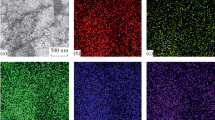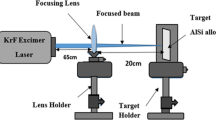Abstract
During the laser surface treatment, oxidation can take place even with the protection of helium gas. The CW-CO2 laser melting of the surface does not induce a large distortion of the crystallographic orientation which remains (1 0 0). A misorientation of 3–4 degrees between the melted zone and the unaffected base alloy was measured by Laue diffraction and ion channelling studies. Surface chemical analysis was carried out by X-ray photoelectron and Auger electron spectroscopies in order to obtain information on surface segregation during either the laser cooling, or after annealing up to 850 °C, in PO2=5 × 10−9 Torr. The latter causes segregation of sulphur and/or nitrogen to the surface. This segregation of sulphur and nitrogen is modified between the untreated zone and the treated surfaces (thermal affected zone and melted zone). For instance, on the contrary of nitrogen, the diffusion of sulphur is increased on the melted surface and the activation energy for this diffusion is very dependent upon the defect nature. A difference of nearly 65–70 kJ mol−1 is calculated for the enthalpy for the surface segregation of sulphur ΔH seg, between the treated and untreated surface. This difference is only 37 kJ mol−1 for nitrogen. In both cases the absolute ΔH seg values are smaller for the treated zone than for the base alloy. A structural study by low electron diffraction (LEED) which gives information on the structure of the surface when clean and in the presence of sulphur and/or nitrogen, shows also the formation of edges, terraces and steps on the treated surfaces. These results are mainly associated with the difference in the content and nature of the defects between the different zones, as observed by scanning electron microscopy analysis or channelling study. Finally a comparison between the mechanical properties of the different zones is made on account of the observation of a linear change of the microhardness on the thermally affected surface. In the thin outer surface zone which is treated by the laser, the stresses associated with the cooling or the isothermal annealing are calculated using formula which associate the stress and the radius of curvature of the sample (from the misorientation which was analysed by ion channelling between the different surface domains). The influence of such an isothermal stress is believed to increase the percentage of vacancies in the melted zone and therefore to modify the activation energy for the diffusion of a substitutional element, such as sulphur. The influence of the elastic energy which is kept during cooling, for example according to the analysis of Evans and Lobb [12], is also discussed.
Similar content being viewed by others
Author information
Authors and Affiliations
Additional information
Part of this work was done in the Laboratoire de Physicochimie des Surfaces, associe au CNRS, ENSCP, Université P et M Curie, 11 rue P et M Curie, 75005 Paris, France.
Rights and permissions
About this article
Cite this article
Moulin, G. The influence of surface melting by CW-CO2 laser on the structure, composition and stress of the (1 0 0) surface of the Fe-17Cr-13Ni alloy. J Mater Sci 26, 756–762 (1991). https://doi.org/10.1007/BF00588315
Issue Date:
DOI: https://doi.org/10.1007/BF00588315




